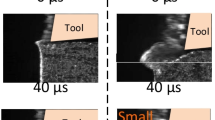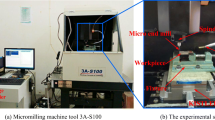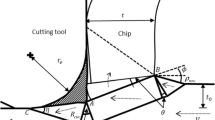Abstract
Based on burr fracture morphology and burr geometry, it is concluded that the main cause of burr formation is the overall metal slip caused by the feed force of sawing and shearing. Based on the assumption that the feed force is uniformly distributed along the incision plane, the burr thickness calculation model for sawing and shearing is formed by coupling the sawing and shear force model and the blanking force model. For preheating temperatures of 500\(\thicksim \)900∘C, feeding speeds of 30\(\thicksim \)90 mm/s, and saw tangent speeds of 3000\(\thicksim \)9000 mm/s, 30 mm × 30 mm GCr15 square steel was used for experiments. Through the calculation model given in this paper, the rule for the influence of the process parameters on burr thickness was obtained. Finally, a sawing and shearing experiment was carried out, and the results show that the maximum relative error between the experimental data and the calculated results is 15%, which verifies the reliability of the calculation model.















Similar content being viewed by others
References
Pramanik A, Basak AK, Uddin MS, Shankar S, Debnath S, Islam MN (2019) Burr formation during drilling of mild steel at different machining conditions. Mater Manuf Process 34(7):726–735. https://doi.org/10.1080/10426914.2019.1594276
Kumar M, Bajpai V (2020) Experimental investigation of top burr formation in high-speed micro-milling of Ti6Al4V alloy. Proceedings of the Institution of Mechanical Engineers Part B-Journal of Engineering Manufacture 234(4):730–738. https://doi.org/10.1177/0954405419883049
Liu GY, Dang JQ, Chen YF, Dong DP, An QL (2019) Numerical and experimental investigation on grinding-induced exit burr formation. Int J Adv Manuf Technol 103(5-8):2331–2346. https://doi.org/10.1007/s00170-019-03641-1
Chen MJ, Ni HB, Wang ZJ, Jiang Y (2012) Research on the modeling of burr formation process in micro-ball end milling operation on Ti-6Al-4V. Int J Adv Manuf Technol 62(9-12):901–912. https://doi.org/10.1007/s00170-011-3865-6
Deng WJ, Xie ZC, Lin P, Xu TK (2012) Study on burr formation at the top edge in rectangular groove cutting. Adv Mater Sci Eng 2012. https://doi.org/10.1155/2012/956208
Tang Y, He ZS, Lu LS, Wang H, Pan MQ (2011) Burr formation in milling cross-connected microchannels with a thin slotting cutter. Precision Engineering-Journal of the International Societies for Precision Engineering and Nanotechnology 35(1):108–115. https://doi.org/10.1016/j.precisioneng.2010.08.004
Yadav AK, Kumar M, Bajpai V, Singh NK, Singh RK (2017) FE Modeling of burr size in high-speed micro-milling of Ti6Al4V. Precision Engineering-Journal of the International Societies for Precision Engineering and Nanotechnology 49:287–292. https://doi.org/10.1016/j.precisioneng.2017.02.017
Fu DK, Ding WF, Yang SB, Miao Q, Fu YC (2017) Formation mechanism and geometry characteristics of exit-direction burrs generated in surface grinding of Ti-6Al-4V titanium alloy. Int J Adv Manuf Technol 89(5-8):2299–2313. https://doi.org/10.1007/s00170-016-9289-6
Bhandari B, Hong YS, Yoon HS, Moon JS, Pham MQ, Lee GB, Huang YC, Linke BS, Dornfeld DA, Ahn SH (2014) Development of a micro-drilling burr-control chart for PCB drilling. Precision Engineering-Journal of the International Societies for Precision Engineering and Nanotechnology 38(1):221–229. https://doi.org/10.1016/j.precisioneng.2013.07.010
Kruy S, Aoyama H, Ohta K, Sano N (2014) Prediction of thickness and height of burr based on burr formation mechanisms in end milling. Journal of Advanced Mechanical Design Systems and Manufacturing 8(4). https://doi.org/10.1299/jamdsm.2014jamdsm0045
Wu X, Li L, He N (2017) Investigation on the burr formation mechanism in micro cutting. Precision Engineering-Journal of the International Societies for Precision Engineering and Nanotechnology 47:191–196. https://doi.org/10.1016/j.precisioneng.2016.08.004
Li PY, He W, Fan YJ, Zheng HT (2018) Investigation on cold-blanking and blanked edge quality of 304 stainless steel sheet. Mater Sci Technol 26(02):34–40. https://doi.org/10.11951/j.issn.1005-0299.20170121
Lin XJ (2012) Calculation research on force and energy parameters of the metal sawing process of circular sawing machine. Master, Central South University
Merchant M (1945) Mechanics of the metal cutting process. II. Plasticity conditions in orthogonal cutting. J Appl Phys 16(6):318–324. https://doi.org/10.1063/1.1707596
Lee E (1951) The theory of plasticity applied to a problem of machining. ASME J Appl Mech 18:405
Oxley PLB, Shaw MC (1990) Mechanics of machining: an analytical approach to assessing machinability. J Appl Mech 57(1):253. https://doi.org/10.1115/1.2888318
Johnson GR, Cook WH (1985) Fracture characteristics of three metals subjected to various strains, strain rates, temperatures and pressures. Eng Fract Mech 21(1):31–48. https://doi.org/10.1016/0013-7944(85)90052-9
Yu CX (2010) Finite element simulation and experimental research of hard cutting process. Master, Harbin University of Science and Technology
Xiao ZY, Fang XD (2001) Discussion of some parameters effecting quality of stamping pieces. Metalforming Machinery 01:13–14 + 11. https://doi.org/10.16316/j.issn.1672-0121.2001.01.007
Liu XH, Wu FJ, Wu HB, Ran XP (2013) Study on high-temperature mechanical properties of GCr15 steel1. Hot Working Technology 42(14):60–63 + 70. https://doi.org/10.14158/j.cnki.1001-3814.2013.14.037
Funding
This work was financially supported by Major science and technology projects of Shanxi Province (20191102009), sponsored by Key r&d projects of Shanxi Province (201903D121049) and Taiyuan PLS Engineering & Technology Company (201810).
Author information
Authors and Affiliations
Corresponding author
Ethics declarations
Conflict of interest
The authors declare that they have no conflict of interest.
Additional information
Publisher’s note
Springer Nature remains neutral with regard to jurisdictional claims in published maps and institutional affiliations.
Rights and permissions
About this article
Cite this article
Wang, C., Shuang, Y., Wang, W. et al. Study of a burr size calculation model for the hot sawing and shearing process. Int J Adv Manuf Technol 110, 605–616 (2020). https://doi.org/10.1007/s00170-020-05823-8
Received:
Accepted:
Published:
Issue Date:
DOI: https://doi.org/10.1007/s00170-020-05823-8




